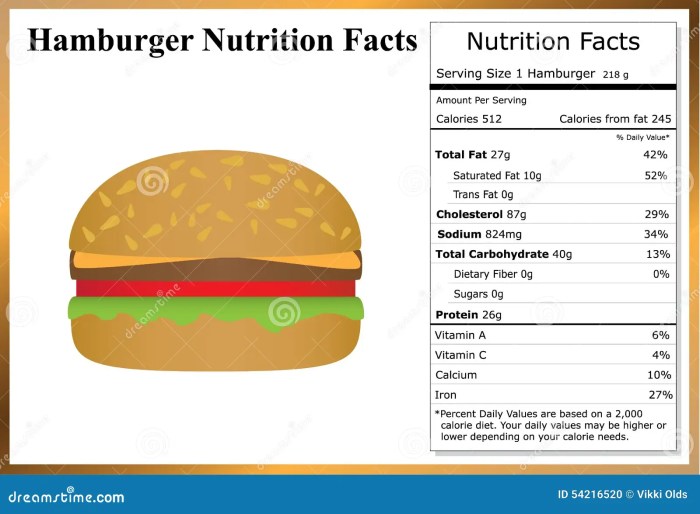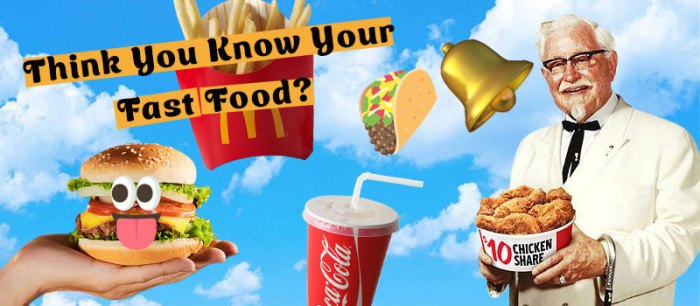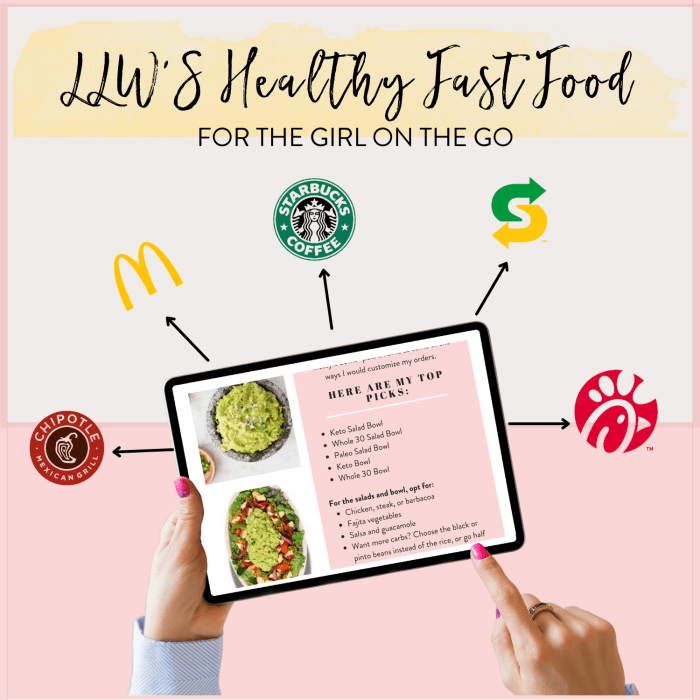Embark on a fast food nutrition web quest to unravel the nutritional secrets of your favorite fast food dishes. Dive into the ingredients, additives, and health implications of these culinary delights. Let’s uncover the impact of fast food consumption on our well-being and explore strategies for making informed choices.
Fast food has become an integral part of our modern lifestyle, offering convenience and taste. However, it’s essential to understand the nutritional value of these meals to make informed decisions about our health.
Fast Food Nutrition Overview

Fast food, characterized by its convenience and affordability, often carries a reputation for being nutritionally inferior. While it can provide some essential nutrients, it’s crucial to understand its limitations and potential health implications.
The fast food nutrition web quest is a great resource for learning about the nutritional content of your favorite fast food meals. If you’re looking for more information about the history of pottery, check out the potters kiln act answers . Then, come back to the fast food nutrition web quest to continue your research on the nutritional content of your favorite fast food meals.
The nutritional value of fast food varies widely depending on the specific item and serving size. However, common ingredients include processed meats, refined carbohydrates, unhealthy fats, and high levels of sodium. These components can contribute to increased calorie intake, weight gain, and chronic health conditions if consumed excessively.
Common Ingredients and Additives
Fast food often relies on processed ingredients to enhance flavor, texture, and shelf life. Some common additives include:
- High-fructose corn syrup: A sweetener linked to obesity, heart disease, and diabetes.
- Trans fats: Unhealthy fats that raise cholesterol levels and increase the risk of cardiovascular disease.
- Sodium: Excessive sodium intake can contribute to high blood pressure and fluid retention.
li>Artificial flavors and colors: Enhance taste and appearance but may have no nutritional value or even be harmful.
Types of Fast Food and Nutritional Profiles
Different types of fast food have varying nutritional profiles. Some examples include:
- Burgers:High in calories, fat, and sodium, with some variations offering higher protein content.
- Fries:Typically fried in unhealthy fats, contributing to high calorie and fat intake.
- Pizza:Can be high in calories, fat, and sodium, but some variations may provide whole grains and vegetables.
- Chicken nuggets:Often processed and high in unhealthy fats and sodium.
- Salads:Can be a healthier option, but watch out for dressings and toppings that add extra calories and fat.
It’s important to note that not all fast food is unhealthy. Some restaurants offer grilled or baked options, whole grains, and fresh produce. By making informed choices and limiting portion sizes, you can minimize the potential negative health effects associated with fast food consumption.
Health Implications of Fast Food Consumption

The allure of fast food lies in its convenience, affordability, and delectable taste. However, beneath its palatable exterior lurks a myriad of health concerns that warrant attention.
Short-Term Effects
Indulging in fast food can lead to an array of immediate health consequences. These include:
- Increased blood sugar levels:Fast food often contains high amounts of refined carbohydrates, which are rapidly digested and absorbed, leading to a spike in blood sugar levels.
- Weight gain:Fast food meals are typically high in calories, fat, and sodium, contributing to weight gain over time.
- Gastrointestinal issues:The high fat and processed ingredients in fast food can irritate the digestive tract, causing discomfort and issues such as indigestion and heartburn.
Long-Term Health Risks
Regular consumption of fast food poses significant long-term health risks, including:
- Cardiovascular disease:The high saturated and trans fats in fast food can increase cholesterol levels, contributing to the development of heart disease and stroke.
- Type 2 diabetes:The frequent consumption of sugary drinks and high-carbohydrate foods in fast food can lead to insulin resistance and eventually type 2 diabetes.
- Obesity:The combination of high calories, fat, and sodium in fast food meals promotes weight gain and increases the risk of obesity.
Statistics and Studies
Numerous studies have demonstrated the detrimental impact of fast food on health. For instance, a study published in the journal JAMA Internal Medicine found that adults who consumed fast food more than twice a week had a 39% increased risk of obesity compared to those who consumed fast food less than once a week.
Another study, published in the journal Circulation, linked regular fast food consumption to an increased risk of cardiovascular disease. The study found that adults who consumed fast food more than twice a week had a 20% higher risk of heart disease compared to those who consumed fast food less than once a month.
Nutritional Comparison of Fast Food and Other Options

Fast food and home-cooked meals offer distinct nutritional profiles. Home-cooked meals typically provide more control over ingredients, portion sizes, and cooking methods, allowing for healthier choices. On the other hand, fast food meals often contain higher amounts of calories, unhealthy fats, sodium, and sugar due to the use of processed ingredients, added oils, and seasonings.
Nutritional Content Differences
The following table compares the nutritional content of a typical fast food meal to a home-cooked meal:| Nutrient | Fast Food Meal | Home-Cooked Meal ||—|—|—|| Calories | 800-1200 | 500-800 || Fat | 40-60g | 20-30g || Saturated Fat | 15-25g | 5-10g || Trans Fat | 2-4g | 0g || Sodium | 1000-1500mg | 500-1000mg || Sugar | 50-100g | 20-50g |As evident from the table, fast food meals tend to be higher in calories, fat, and sodium, while home-cooked meals offer lower levels of these nutrients.
Additionally, fast food meals often contain trans fats, which are harmful to heart health, while home-cooked meals typically do not.
Strategies for Making Healthier Fast Food Choices: Fast Food Nutrition Web Quest

Making healthier fast food choices can be challenging, but it’s possible with some planning and effort. Here are some tips and strategies to help you:
Portion Control
Fast food portions are often oversized, leading to excessive calorie intake. To avoid overeating, choose smaller sizes, share meals with friends, or ask for a to-go box and save half for later.
Mindful Eating, Fast food nutrition web quest
Pay attention to your hunger cues and eat slowly to avoid overindulging. Take breaks during your meal to assess your fullness and stop eating when you’re satisfied.
Healthier Options
Many fast food restaurants offer healthier options, such as:
- Grilled or baked chicken sandwiches instead of fried
- Salads with grilled protein and vegetables
- Fruit cups or yogurt parfaits for dessert
Role of Education and Awareness

Empowering consumers with knowledge about fast food nutrition is paramount to promoting healthier choices. Nutrition education campaigns can help individuals understand the nutritional content of fast food items, recognize healthier options, and make informed decisions.
Government Regulations and Industry Initiatives
Government regulations and industry initiatives play a crucial role in improving fast food nutrition. Regulations can mandate the disclosure of nutritional information on food packaging and menus, enabling consumers to make informed choices. Industry initiatives, such as voluntary sodium reduction programs, can encourage fast food companies to offer healthier options.
Successful Campaigns and Programs
Several successful campaigns and programs have increased awareness about fast food nutrition. For example, the Centers for Disease Control and Prevention’s (CDC) “Choose Healthier” campaign provides resources and tools to help consumers make healthier choices when eating out. Another notable initiative is the “Healthier Hospitals Initiative,” which encourages hospitals to offer healthier food options to patients and visitors.
Essential FAQs
Is all fast food unhealthy?
No, not all fast food is unhealthy. Some fast food restaurants offer healthier options, such as grilled chicken sandwiches, salads, and fruit cups.
What are some tips for making healthier fast food choices?
When choosing fast food, opt for grilled or baked items instead of fried options. Choose whole-wheat bread or wraps over white bread. Request for extra vegetables and fruits, and limit sugary drinks.
How can I reduce the sodium intake from fast food?
Ask for your food to be prepared without added salt. Avoid processed meats, such as bacon and sausage, which are high in sodium. Choose unsalted side dishes, such as fruit or yogurt.
